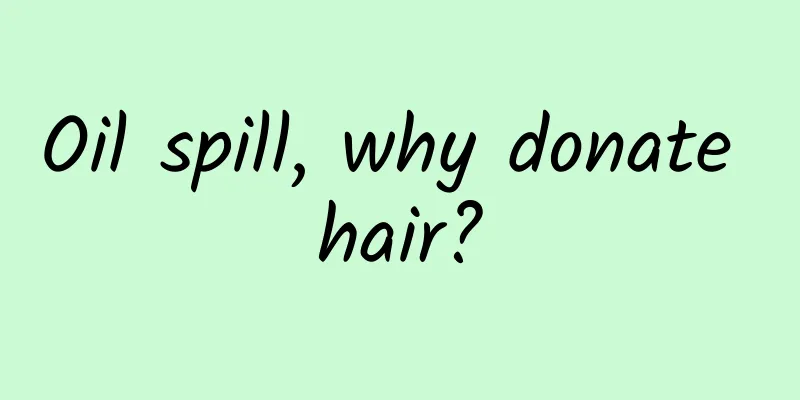Oil spill, why donate hair?

|
In the long history of the evolution of life on Earth, the appearance of hair is just a trivial event. For most animals, hair is just a tool for protection, warmth or attracting the opposite sex. However, for humans, hair does more than that. Do you think that long hair is just for comfort and good looks? In fact, hair also has connotations! On January 14, 2022, the tsunami caused by the eruption of the Tonga volcano affected the world. The coast of Lima, Peru, 10,000 kilometers away, was not spared. The waves hit an oil tanker that was unloading crude oil, causing more than 6,000 barrels of crude oil to leak into the ocean. 21 beaches along the Pacific coast of Peru were polluted by the oil spill, causing "the worst ecological disaster in modern history." Image source: USA TODAY Faced with the arduous task of cleaning up the oil spill, the Peruvian government came up with an unexpected solution - calling on citizens to donate their hair ! Peruvian girl donates her hair to help clean up oil spill Image source: Bloomberg Quicktake The Peruvian government wants to donate hair to the oil spill to purify the seawater. Image source: euronews This sausage-shaped device can handle oil spills because hair can absorb oil. This discovery is mainly attributed to a teacher named Tony. In March 1989, the Exxon Valdez oil tanker of the US Exxon Company hit a reef near Alaska, causing 11 million gallons of oil to leak. A senior barber named Phillip McCrory watched the TV broadcast and saw sea otters soaked in oil. This gave him an idea: Animal hair can absorb oil, so can human hair? Sea otters covered in thick oil. Image source: www.core77.com So Tony did an experiment, and the results were astonishing: hair can not only absorb oil, but also a lot of it! According to calculations, on average, 1 kg of hair can absorb 8 kg of oil ! And he found that hair absorbs rather than absorbs oil . In other words, the oil does not bind to the hair, but accumulates on the surface of the hair, and can be easily recovered by squeezing the oil out of the hair. Image source: imgur.com McClory found patents similar to his idea that involved using materials such as wool and duck feathers to absorb oil, but they were not as absorbent as human hair. He submitted his findings to NASA and received further confirmation. McClory then developed the oil-absorbing "hair pad" device and applied for a patent in 1993 . Image source: howstuffworks So the question is, why can hair absorb a lot of oil but not water? This is determined by the "oil-absorbing" structural characteristics of hair. 65% to 95% of hair is composed of keratin, which is extremely hydrophobic ; while oil is mainly composed of various hydrocarbons. According to the principle of like dissolves like, hair is lipophilic and hydrophobic, and naturally likes to mix with oil. Friends who suffer from oily hair should have a deep understanding of this. Image source: ca.style.yahoo.com At the same time, the surface of hair is not smooth, and each hair surface is full of holes and cracks. The outermost layer of hair is usually composed of 2 to 4 layers of scales, which are like tiny suction cups, allowing the hair to fully contact the oil and effectively absorb the oil . Therefore, hair has become a natural "oil-absorbing sponge", and its oil absorption effect in water is even better than other chemical oil absorbents, which is simply a magic weapon for cleaning oil spills. Hair scale diagram & microscopic photo Image source: Reference [4] If McClory discovered that hair can handle oil, then the one who really promoted and developed this technology was a non-profit organization called Matter of Trust. The founder of the organization, Lisa Gautier, approached McClory and invited him to conduct a series of research and experiments on hair absorbing oil, and to promote and use related technologies to solve environmental problems. Left: McClory, the discoverer of hair oil absorption. Right: Lisa Gautier, founder of "Matter of Trust". Source: matteroftrust.org Oil recovery unit Image source: matteroftrust.org Hair oil absorption is environmentally friendly , highly efficient and inexpensive (mainly relying on donations). In the 1998 California oil spill, the 2007 San Francisco Bay oil spill and the 2010 Gulf of Mexico oil spill, a large amount of hair was used to make oil absorbent pads at the call of organizations such as Matter of Trust and was put into the oil spill cleanup work, playing a vital role. After the 2010 Gulf of Mexico oil spill, residents of West Michigan, USA, spontaneously organized to donate their hair. Source: www.mlive.com Despite this, hair oil absorption technology has not been widely promoted. First of all, it is said that a person's hair grows about 1.25 cm a month, and only grows about 50 g a year (under ideal conditions of continuous growth and no shedding!), and it takes at least 20 years for a person to accumulate 1 kg of hair! Therefore, collecting enough hair requires a lot of time and manpower. Secondly, hair oil absorption pads are mainly suitable for the adsorption of surface oil stains , and their effect is limited for deep or dispersed oil stains. In addition, in large-scale sudden oil spills, it is difficult to quickly obtain a large amount of hair, and chemical oil absorbents are more efficient and convenient. Widely used oil absorbent pads are usually made of polypropylene of varying thicknesses. The pads are woven from single or multiple layers of polypropylene fibers. Image source: www.absorbentsonline.com Chemical oil absorbents are used to absorb or dissolve oil. Common materials include polypropylene (PP), flax fiber, polyester synthetic fiber, and zeolite. Dispersants, curing agents, and neutralizers are also used to treat oil spills. These compounds treat oil spills by reducing the surface tension of the oil-water interface, forming solid substances, or changing the chemical properties of the oil. Chemical oil absorbents have a fast adsorption rate, are suitable for large-scale leaks, and are easy to mass produce and use . Compared with hair, chemical oil absorbents can respond to large-scale oil spills in a timely manner, but may cause ecosystem damage to the environment and are difficult to degrade. Using hair compost to enrich soil nitrogen Source: www.doityourself.com In fact, oil absorption is only one of the abilities of hair. On the premise of solving the collection and safety issues, hair has many other uses : it can absorb heavy metals in water to purify water; it can be used as fertilizer to provide nitrogen elements needed by plants and has an insect repellent effect; it can be used for agricultural water conservation; it can be used as a raw material for extracting amino acids for pharmaceuticals, and it can also be used as surgical sutures, etc. In addition, what other uses can you think of for hair? Feel free to add in the comment section~ References [1]Hair Matters Program History | MatterofTrust.org [2] BD McCrory and PA McCrory. Device for containing and absorbing oil spills on water: US Patent 5453191 [P]. 1995-09-26. [3] PA McCrory. Device for absorbing oil from water: US Patent 6146529 [P]. 2000-11-14. [4] Deedrick DW, Koch S L. Microscopy of hair part 1: a practical guide and manual for human hairs[J]. Forensic science communications, 2004, 6(1). [5] Murray, Megan L., Soeren M. Poulsen, and Brad R. Murray. "Decontaminating terrestrial oil spills: a comparative assessment of dog fur, human hair, peat moss and polypropylene sorbents." Environments 7.7 (2020): 52. [6] Pagnucco, Rebecca, and Megan L. Phillips. "Comparative effectiveness of natural by-products and synthetic sorbents in oil spill booms." Journal of environmental management 225 (2018): 10-16. [7] Gupta A. Human hair “waste” and its utilization: gaps and possibilities[J]. Journal of waste management, 2014, 2014. [8] Zheljazkov VD, Silva JL, Patel M, et al. Human hair as a nutrient source for horticultural crops[J]. HortTechnology, 2008, 18(4): 592-596. Author: Ji Minghua, PhD, Shanghai Advanced Research Institute, Chinese Academy of Sciences Planning & Editing: Little Dandelion Cover image source: 91 |
Recommend
Deloitte Consulting: Generative Artificial Intelligence Report, Q2 2024
Value creation The proportion of organizations re...
A historical review: The 12 most important WWDC moments in Apple's development
[[136059]] Why this matters Apple's annual Wo...
After studying 200+ brand cases, 50 product and marketing thoughts were summarized
Regarding brands, new consumption, and marketing,...
【Android】I can’t describe this effect
Preface I recently received a request that made m...
Analysis of Himalaya's competitive products
Preface : From Himalaya , I have briefly analyzed...
XBB.1.16 has been detected in China. Do we have enough "new coronavirus antibodies" in our bodies?
recently #XBB.1.16 strain# Becoming the focus of ...
Interpretation of iResearch's 2014 DSP Industry Analysis Report
iResearch recently released the "2014 DSP In...
How can content operations play their own value?
Content operation is becoming more and more impor...
Zi Fei: Saving the Anxiety of Perfectionists
Course catalog: ├──01..Introduction to Perfectioni...
The mother-in-law didn’t turn on the air conditioner, causing a pregnant woman to get heatstroke and be sent to the hospital. At what temperature should the air conditioner be turned to save electricity and be healthy?
The summer solstice is approaching, and the tempe...
Activity operation theme planning and front-end gameplay design
After implementing and determining the backend st...
Information flow advertising: Before you fight with the data, think about your purpose
Let me first tell you a real case we received: Xi...
APP User Experience Report | Xianyu, how to play with the idle community?
In this article, the author analyzes Xianyu’s use...









